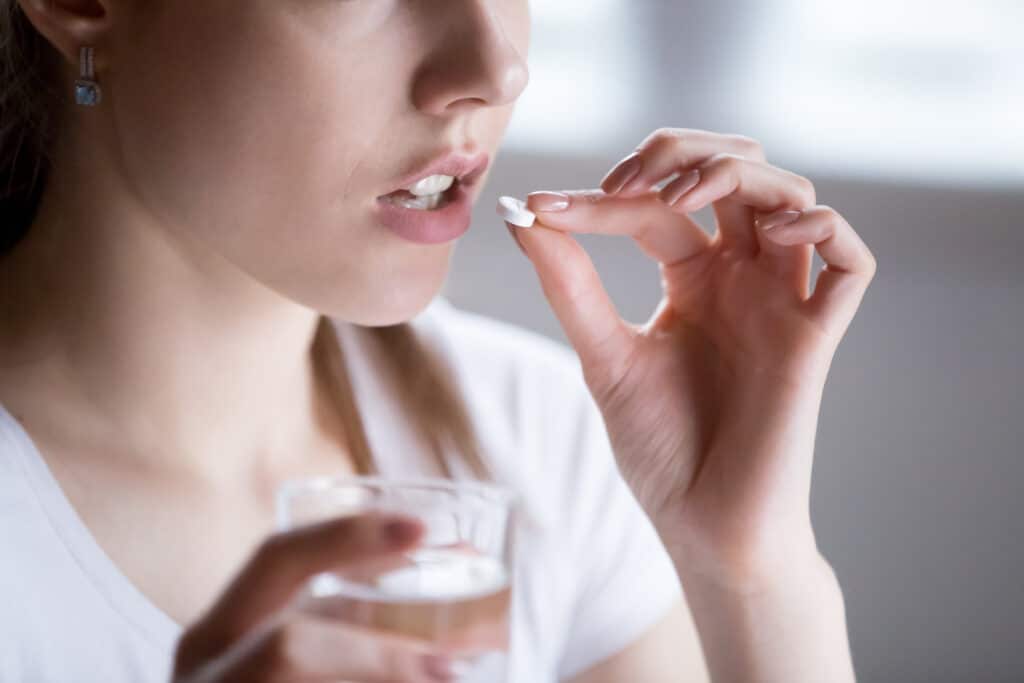- Bacterial Vaginosis and Yeast Infections are two of the most common bacterial infections experienced by women.
- Although they both have very similar symptoms, such as itching, pain while urinating, and swelling of the vulva, they can be easily differentiated by examining (1) the color and thickness of discharge and (2) any unusual smells accompanying other symptoms.
- Bacterial Vaginosis is commonly accompanied by an unfamiliar smell whereas Yeast Infections usually do not have a smell.
- Bacterial Vaginosis usually has thin and gray discharge whereas Yeast Infections come with bulkier, almost cottage cheese-like discharge.
- Both Vaginal Infections are common and easily treatable.
We get it…You’ve been searching the web, typing in some symptoms that you’ve been experiencing like a strange itch or unusual discharge, and landing on pages that make you fearful of what could possibly be going on with your vagina.
Bacterial Vaginosis, Yeast Infection, UTI, Trichomoniasis, and the list goes on…

So first: take a deep breath. We know it’s not fun (or comfortable) but common vaginal infections are totally normal, treatable, and something we should talk about more often. We’re here to walk you through what causes common infections like BV (bacterial vaginosis) or yeast infections, how to tell them apart, and what you can do to take control of your vaginal health.
At Happy V, we believe that information should be easily available, accessible, and actionable — and we’re here to support you at every step! Let’s start with key takeaways on telling the difference between BV and Yeast Infections:
What Are The Symptoms of BV?
- Thin, and gray, white or green vaginal discharge
- An unusual and sometimes fishy or metallic/ionic vaginal odor
- Vaginal itching
- Burning during urination
What Are The Symptoms of Yeast Infections?
- Burning, redness, and swelling of the vagina and the vulva
- Pain when urinating
- Pain during sex
- Soreness
- A thick, white vaginal discharge that looks like cottage cheese and does not have a bad odor
BV and yeast infections are just two of many vaginal infections that fall under a range of common vaginal infections known as vaginitis Knowing what symptoms to look for is an important first step in your road to treating the root causes, but understanding what causes these infections is also critical to preventing them for the long term.
What is Bacterial Vaginosis?
Did you know around 21.2 million women aged 14 to 49 in the United States alone have bacterial vaginosis (BV), and 84% of these women didn’t experience any symptoms at all?
Bacterial Vaginosis is an imbalance of good to bad bacteria which may lead to the symptoms you may be facing at this very moment. The symptoms of BV may include:
- An unfamiliar smell that can smell both fishy, ionic or metallic
- A higher than usual pH (which is measured by peeing on a pH stick)
- Discharge that can be thin and gray to yellow
- And sometimes itching and burning when peeing
Read our Ultimate Guide to Bacterial Vaginosis to learn more about the science behind BV, symptoms and treatment options!
Physicians and researchers often refer to BV as a vaginal microbiome dysbiosis, rather than considering it as an infection or a disease. What this means is that they consider that the microbiome or vaginal flora is not in a balance which therefore causes the symptoms. It is more common in women that are at reproductive age (i.e. 16-44) and during pregnancy. About half of the cases from gynecological problems reported every year are related to BV, so don’t worry you are not alone.
How does Bacterial Vaginosis occur?
To understand how Bacterial Vaginosis occurs, we need to get to talk about the most prominent bacteria in the vagina – Lactobacillus. Don’t be alarmed! Not all bacteria are bad, and in this case, Lactobacillus is a friendly probiotic with a host of benefits, including:
- Producing lactic acid as a natural defense against bad bacteria
- Maintaining optimal pH at 3.8-4.5
- Displacing pathogens in the epithelium – the nutrient site for these probiotics
So why is it important to know about Lactobacillus? It is when these allies, Lactobacillus, are depleted that pH changes, creating a less acidic environment that is perfect for pathogens (the bad bacteria) to come in, consume nutrients and create the toxins that cause Bacterial Vaginosis.
As BV progresses, a dense biofilm covers the vaginal walls. This allows harmful bacteria to hide behind the wall, nurturing them and making it almost impossible for antimicrobial agents and good bacteria to fight them.
The signs of this infection include abnormal vaginal discharge which is a thin grayish-white or yellow in color and an unfamiliar odor coming from your vagina.
The reason as to why Bv starts in the first place can be due to things such as multiple sexual partners, not eating a nutritious diet, not changing out of gym clothes, and one of the common reasons for anaerobic bacterial growth: douching! Cleaning your vagina with chemicals will cause an imbalance in the first place!
What is a Yeast Infection?
In the U.S., vaginal yeast infections are the second-most common vaginal infection type, and there are around 1.4 million patients reported every year. It’s a huge issue that so many deal with.
Similar to BV which occurs due to an imbalance of good to bad bacteria, Yeast Infections (also known as Candida Vulvovaginitis or Vulvuvaginal Candidiasis) are caused by an overgrowth of a specific fungus known as Candida Albicans.
When lower amounts of Lactobacillus are in the body, it cannot produce acid which used to discourage the overgrowth of natural yeast. When the body’s healthy bacteria falls out of balance, candida, or bad bacteria, accumulates and causes a yeast infection.
Now before we dive any deeper, we want you to know that Candida is not always harmful – vaginal yeast is actually considered healthy when it is not overgrowing and it’s a common microorganism that can also be found in your mouth, intestines, and skin!
How does a Yeast Infection occur?
Yeast Infections are caused by the growth and multiplying of natural yeast that is present in the vagina. Yeast Infections love when the conditions are just right within the vagina – that means higher than normal pH and moist, damp environment.
Here’s why the body can create too much yeast:
- Maybe you’re on antibiotics, which can affect your vaginal flora and impair beneficial bacteria like lactobacillus
- Maybe you have undiagnosed diabetes or poor blood sugar regulation
- Cold and flu season? You may be fighting things off with a weakened immune system
- Are you on birth control? The higher estrogen can be a factor, too
It’s really important to understand what the symptoms of a yeast infection can look and feel like. You may experience:
- Vaginal swelling
- Itching, pain or vaginal irritation
- Redness around the vulva or vaginal opening.
- Redness, burning, and pain during sex or urination
- Thick, white, odorless discharge
Treating a yeast infection is really important, or you risk experiencing other side effects of an untreated infection, which could look like fatigue or gastrointestinal issues.
How long can a Yeast Infection Last?
The duration of a Yeast Infection is proportional to the severity of the infection: If the Yeast Infection is mild then it will clear up in a couple of days. If it is moderate to severe infection with uncomfortable symptoms then it may require medical attention and prescription treatment or asking your doctor to recommend the right OTC.
Now that you know the difference between BV and a Yeast Infection, let’s discuss how you can tell them apart.
What’s the difference between a Yeast Infection and BV?
Both of these infections have similar signs and symptoms, making it difficult for women to differentiate the two. For example, itchiness and burning around the vulva or vagina, burning sensation while urinating, pain while having sex, and sometimes anal itching can occur. Here are some ways to tell the difference between BV and Yeast Infections:
- ODOR — The vaginal discharge produced as a result of a Yeast Infection is typically unaccompanied by odor. The discharge produced as a result of BV has a strong and unusual smell.
- TEXTURE — The texture of the discharge in the case of a Yeast Infection is lumpy or cottage cheese-like and thick. The discharge produced in BV infection is usually thin and milky.
- COLOR — The color of discharge can help you determine what infection you are experiencing. In the case of a yeast infection, the discharge is normally whitish in color. The color of the discharge in a BV infection will be grayish-white.
Normally, BV is recurrent and its symptoms worsen after sex, whereas the symptoms of a Yeast Infection can be controlled, especially during pregnancy or when you are taking hormonal supplements. This can also help you identify the type of infection you have.
What Happens If I Don’t Get Treated?
We hope that understanding the main differences between these BV and Yeast Infections helps you navigate and take control of your vaginal health. For the most part, these infections are common. But its extremely important that you take any weirdness or discomfort seriously.
If these infections remain untreated for a long period of time, they might become chronic and recurrent in nature. Not only that, but studies also show that they can lead to other conditions such as Pelvic Inflammatory Disease (PID), different types of vagina and cervix problems, infertility and premature delivery issues, and more. If left untreated, BV can increase the risk of catching an STI.
Can I Have BV & Yeast Infection At The Same Time?
So to be direct, yes it’s possible to have both at the same time, and it is likely that if you cannot tell the differences between the BV symptoms and yeast infection symptoms we listed above, that it might be what you are currently experiencing.
Remember, BV occurs because of pH imbalances due to lactobacillus not being abundant enough to compete against pathogens, or bad bacteria, from taking the essential prebiotics needed to make lactic acid. This allows bad bacteria to overwhelm the good bacteria and the symptoms are soon to follow. Yeast infections occur because those same lactobacilli are not creating the lactic acid needed to not allow the yeast to overgrow and overpopulate the vaginal flora.
Now it seems with this breakdown that you would assume that yeast infection and bacterial vaginosis are always together every single time, but that’s not the case, just because BV is occurring doesn’t mean Yeast will necessarily overgrown. That’s why it’s vital, even with a 100% correct self-diagnosis, to go see your primary physician or OBGYN and get a medical opinion.
Tips for a Happy V
How do you prevent vaginal infections from happening? Remember, lactobacillus is actually a normal and healthy part of bodily function. When the balance is just right, you won’t experience any problems, and the bacteria actually help you stay healthy and halt the production of yeast.
Here are four tips for keeping a happy V:
- Try a diet that’s high in probiotic foods because it may keep your vaginal pH in balance. Think yogurt with live strains, kimchi, tempeh, and more, or take a dietary probiotic supplement.
- Limit sugar content in your diet.
- Don’t douche! Just don’t do it. Douching not only washes away the bad bacteria but the food as well. The vagina has a natural process for cleaning.
- How can your fitness routine be harming your vaginal wellness? Well, wearing gym clothes can increase your likelihood of getting BV or a yeast infection. Change clothes after leaving the gym, and bring a change of underwear after class, running, or lifting heavy.
- Focus on healthy eating habits and lowering your stress. We’re more prone to infection during high-stress times in our lives, and excess cortisone production weakens the immune system.
So now what?
Congratulations! You have finished your crash course in differentiating between Yeast Infections and Bacterial Vaginosis! Now what?
We suggest checking out Happy V Probiotics, made with clinically proven strains made for balancing the vaginal flora, which is critical to maintaining a balanced pH and overall vaginal health.
And if you want to learn more about what you can do to prevent vaginal infections from recurring, check out our article on how to keep your vagina healthy!
Bacterial Vaginosis, Annual Review of Medicine: Vol. 51:349-356 (Volume publication date February 2000)




